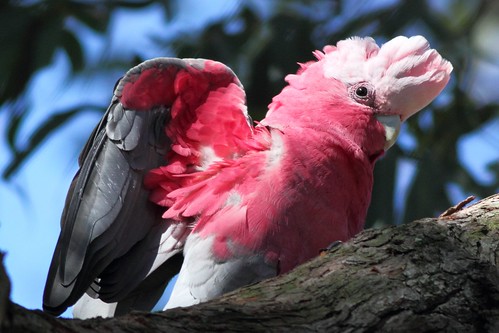 A Galah is a common Graden bird in Canbarra. Image by Wayne ButterworthIf sulphur-crested cockatoos weren't so fussy about nesting sites they'd probably replace galahs as Canberra's most abundant bird species.
A Galah is a common Graden bird in Canbarra. Image by Wayne ButterworthIf sulphur-crested cockatoos weren't so fussy about nesting sites they'd probably replace galahs as Canberra's most abundant bird species.
Author and internationally recognised parrot expert Joe Forshaw says cockatoos' amazing presence in Canberra happened even though older, established birds did all the breeding.
Numerous other adults either wait for a big tree hollow to be vacated or will never breed.
Galahs, on the other hand, breed almost anywhere, even in rabbit burrows and pipes.
Mr Forshaw discovered and filled one of the biggest voids in the history of Australian parrots - a lack of books - on this colourful, intelligent species.
In his boyhood days in Dubbo, bird-keeping was a huge hobby which led him to work in CSIRO Wildlife where he discovered many scientists regarded parrots as mere aviary species unworthy of publications.
His first book, Australian Parrots, in 1969 was followed by Parrots of the World. Both brought acclaim and exceptional insight into the avian community.
 Landing Galah. Image by Roger BlieschkeFrom watching birds throughout NSW country towns where his father worked on the railway, Mr Forshaw later travelled the world. Today, retired at Amaroo from the public service but still adding to an impressive pile of bird books, he rejoices in the extraordinary rise of parrots.
Landing Galah. Image by Roger BlieschkeFrom watching birds throughout NSW country towns where his father worked on the railway, Mr Forshaw later travelled the world. Today, retired at Amaroo from the public service but still adding to an impressive pile of bird books, he rejoices in the extraordinary rise of parrots.
''With the galahs, we've helped them enormously. We've cleared the forests from the mountain ranges so they have been able to come from the interior to the coast, they just followed the farmland all the way through, same with the little corella.
''We helped them both ways, we've opened up dry arid areas to stock and we put in watering places.''
Extroverted show-offs, he says galahs become excited with rain.
''I watched them yesterday, long before the rain built up they were flying around here and screeching madly … They love rain.''
A few years ago, he visited a Victorian national park with a colleague where they saw these birds so high in the air they were dots.
''We suddenly realised it was raining up there and the rain wasn't making it down to the ground. They were all in the rain up high, they were so high it was incredible.''
Mr Forshaw said unlike most birds, parrots retain their capacity to learn throughout life.
When roadworkers line new work with grass seed and straw, galahs are the first to swoop down on it to feed.
Every day walking with his dog down to Yerrabi Pond, he sees five species of parrots and doubts there'd be a more diverse collection than Canberra's anywhere in the world - except maybe Sydney because of their lorikeets.
Loss of habitat and climate change will likely wipe out the orange-bellied parrot and is threatening gang-gang cockatoos.
Better habitat management could reverse the decline, as seen in a resurgence over more than 30 years of the superb parrot, including at Mulligan's Flat Nature Reserve through to Hall.